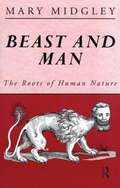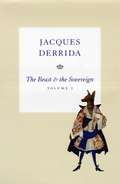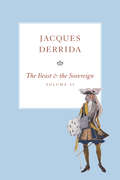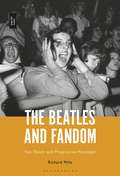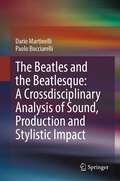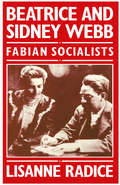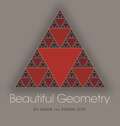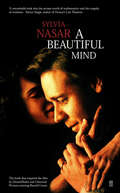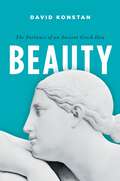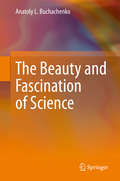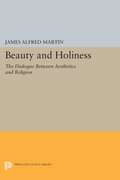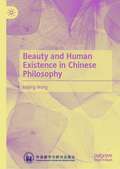- Table View
- List View
Beast and Man: The Roots of Human Nature
by Mary Midgley`Beast and Man is a brilliant and persuasive attempt to set us in our animal context, ... and to indicate a morality for a society without religious absolutes - a morality of which we see the rudiments in our brother species.' - The Observer
The Beast and the Sovereign, Volume I (The Seminars of Jacques Derrida #v. 1)
by Jacques DerridaWhen he died in 2004, Jacques Derrida left behind a vast legacy of unpublished material, much of it in the form of written lectures. With The Beast and the Sovereign, Volume 1, the University of Chicago Press inaugurates an ambitious series, edited by Geoffrey Bennington and Peggy Kamuf, translating these important works into English. The Beast and the Sovereign, Volume 1 launches the series with Derrida’s exploration of the persistent association of bestiality or animality with sovereignty. In this seminar from 2001–2002, Derrida continues his deconstruction of the traditional determinations of the human. The beast and the sovereign are connected, he contends, because neither animals nor kings are subject to the law—the sovereign stands above it, while the beast falls outside the law from below. He then traces this association through an astonishing array of texts, including La Fontaine’s fable “The Wolf and the Lamb,” Hobbes’s biblical sea monster in Leviathan, D. H. Lawrence’s poem “Snake,” Machiavelli’s Prince with its elaborate comparison of princes and foxes, a historical account of Louis XIV attending an elephant autopsy, and Rousseau’s evocation of werewolves in The Social Contract. Deleuze, Lacan, and Agamben also come into critical play as Derrida focuses in on questions of force, right, justice, and philosophical interpretations of the limits between man and animal.
The Beast and the Sovereign, Volume I (The Seminars of Jacques Derrida #v. 1)
by Jacques DerridaWhen he died in 2004, Jacques Derrida left behind a vast legacy of unpublished material, much of it in the form of written lectures. With The Beast and the Sovereign, Volume 1, the University of Chicago Press inaugurates an ambitious series, edited by Geoffrey Bennington and Peggy Kamuf, translating these important works into English. The Beast and the Sovereign, Volume 1 launches the series with Derrida’s exploration of the persistent association of bestiality or animality with sovereignty. In this seminar from 2001–2002, Derrida continues his deconstruction of the traditional determinations of the human. The beast and the sovereign are connected, he contends, because neither animals nor kings are subject to the law—the sovereign stands above it, while the beast falls outside the law from below. He then traces this association through an astonishing array of texts, including La Fontaine’s fable “The Wolf and the Lamb,” Hobbes’s biblical sea monster in Leviathan, D. H. Lawrence’s poem “Snake,” Machiavelli’s Prince with its elaborate comparison of princes and foxes, a historical account of Louis XIV attending an elephant autopsy, and Rousseau’s evocation of werewolves in The Social Contract. Deleuze, Lacan, and Agamben also come into critical play as Derrida focuses in on questions of force, right, justice, and philosophical interpretations of the limits between man and animal.
The Beast and the Sovereign, Volume I (The Seminars of Jacques Derrida #v. 1)
by Jacques DerridaWhen he died in 2004, Jacques Derrida left behind a vast legacy of unpublished material, much of it in the form of written lectures. With The Beast and the Sovereign, Volume 1, the University of Chicago Press inaugurates an ambitious series, edited by Geoffrey Bennington and Peggy Kamuf, translating these important works into English. The Beast and the Sovereign, Volume 1 launches the series with Derrida’s exploration of the persistent association of bestiality or animality with sovereignty. In this seminar from 2001–2002, Derrida continues his deconstruction of the traditional determinations of the human. The beast and the sovereign are connected, he contends, because neither animals nor kings are subject to the law—the sovereign stands above it, while the beast falls outside the law from below. He then traces this association through an astonishing array of texts, including La Fontaine’s fable “The Wolf and the Lamb,” Hobbes’s biblical sea monster in Leviathan, D. H. Lawrence’s poem “Snake,” Machiavelli’s Prince with its elaborate comparison of princes and foxes, a historical account of Louis XIV attending an elephant autopsy, and Rousseau’s evocation of werewolves in The Social Contract. Deleuze, Lacan, and Agamben also come into critical play as Derrida focuses in on questions of force, right, justice, and philosophical interpretations of the limits between man and animal.
The Beast and the Sovereign, Volume I (The Seminars of Jacques Derrida #v. 1)
by Jacques DerridaWhen he died in 2004, Jacques Derrida left behind a vast legacy of unpublished material, much of it in the form of written lectures. With The Beast and the Sovereign, Volume 1, the University of Chicago Press inaugurates an ambitious series, edited by Geoffrey Bennington and Peggy Kamuf, translating these important works into English. The Beast and the Sovereign, Volume 1 launches the series with Derrida’s exploration of the persistent association of bestiality or animality with sovereignty. In this seminar from 2001–2002, Derrida continues his deconstruction of the traditional determinations of the human. The beast and the sovereign are connected, he contends, because neither animals nor kings are subject to the law—the sovereign stands above it, while the beast falls outside the law from below. He then traces this association through an astonishing array of texts, including La Fontaine’s fable “The Wolf and the Lamb,” Hobbes’s biblical sea monster in Leviathan, D. H. Lawrence’s poem “Snake,” Machiavelli’s Prince with its elaborate comparison of princes and foxes, a historical account of Louis XIV attending an elephant autopsy, and Rousseau’s evocation of werewolves in The Social Contract. Deleuze, Lacan, and Agamben also come into critical play as Derrida focuses in on questions of force, right, justice, and philosophical interpretations of the limits between man and animal.
The Beast and the Sovereign, Volume I (The Seminars of Jacques Derrida #v. 1)
by Jacques DerridaWhen he died in 2004, Jacques Derrida left behind a vast legacy of unpublished material, much of it in the form of written lectures. With The Beast and the Sovereign, Volume 1, the University of Chicago Press inaugurates an ambitious series, edited by Geoffrey Bennington and Peggy Kamuf, translating these important works into English. The Beast and the Sovereign, Volume 1 launches the series with Derrida’s exploration of the persistent association of bestiality or animality with sovereignty. In this seminar from 2001–2002, Derrida continues his deconstruction of the traditional determinations of the human. The beast and the sovereign are connected, he contends, because neither animals nor kings are subject to the law—the sovereign stands above it, while the beast falls outside the law from below. He then traces this association through an astonishing array of texts, including La Fontaine’s fable “The Wolf and the Lamb,” Hobbes’s biblical sea monster in Leviathan, D. H. Lawrence’s poem “Snake,” Machiavelli’s Prince with its elaborate comparison of princes and foxes, a historical account of Louis XIV attending an elephant autopsy, and Rousseau’s evocation of werewolves in The Social Contract. Deleuze, Lacan, and Agamben also come into critical play as Derrida focuses in on questions of force, right, justice, and philosophical interpretations of the limits between man and animal.
The Beast and the Sovereign, Volume I (The Seminars of Jacques Derrida #v. 1)
by Jacques DerridaWhen he died in 2004, Jacques Derrida left behind a vast legacy of unpublished material, much of it in the form of written lectures. With The Beast and the Sovereign, Volume 1, the University of Chicago Press inaugurates an ambitious series, edited by Geoffrey Bennington and Peggy Kamuf, translating these important works into English. The Beast and the Sovereign, Volume 1 launches the series with Derrida’s exploration of the persistent association of bestiality or animality with sovereignty. In this seminar from 2001–2002, Derrida continues his deconstruction of the traditional determinations of the human. The beast and the sovereign are connected, he contends, because neither animals nor kings are subject to the law—the sovereign stands above it, while the beast falls outside the law from below. He then traces this association through an astonishing array of texts, including La Fontaine’s fable “The Wolf and the Lamb,” Hobbes’s biblical sea monster in Leviathan, D. H. Lawrence’s poem “Snake,” Machiavelli’s Prince with its elaborate comparison of princes and foxes, a historical account of Louis XIV attending an elephant autopsy, and Rousseau’s evocation of werewolves in The Social Contract. Deleuze, Lacan, and Agamben also come into critical play as Derrida focuses in on questions of force, right, justice, and philosophical interpretations of the limits between man and animal.
The Beast and the Sovereign, Volume II (The Seminars of Jacques Derrida #v. 1)
by Jacques DerridaFollowing on from The Beast and the Sovereign, Volume I, this book extends Jacques Derrida’s exploration of the connections between animality and sovereignty. In this second year of the seminar, originally presented in 2002–2003 as the last course he would give before his death, Derrida focuses on two markedly different texts: Heidegger’s 1929–1930 course The Fundamental Concepts of Metaphysics, and Daniel Defoe’s Robinson Crusoe. As he moves back and forth between the two works, Derrida pursuesthe relations between solitude, insularity, world, violence, boredom and death as they supposedly affect humans and animals in different ways. Hitherto unnoticed or underappreciated aspects of Robinson Crusoe are brought out in strikingly original readings of questions such as Crusoe’s belief in ghosts, his learning to pray, his parrot Poll, and his reinvention of the wheel. Crusoe’s terror of being buried alive or swallowed alive by beasts or cannibals gives rise to a rich and provocative reflection on death, burial, and cremation, in part provoked by a meditation on the death of Derrida’s friend Maurice Blanchot. Throughout, these readings are juxtaposed with interpretations of Heidegger's concepts of world and finitude to produce a distinctively Derridean account that will continue to surprise his readers.
The Beast and the Sovereign, Volume II (The Seminars of Jacques Derrida #v. 1)
by Jacques DerridaFollowing on from The Beast and the Sovereign, Volume I, this book extends Jacques Derrida’s exploration of the connections between animality and sovereignty. In this second year of the seminar, originally presented in 2002–2003 as the last course he would give before his death, Derrida focuses on two markedly different texts: Heidegger’s 1929–1930 course The Fundamental Concepts of Metaphysics, and Daniel Defoe’s Robinson Crusoe. As he moves back and forth between the two works, Derrida pursuesthe relations between solitude, insularity, world, violence, boredom and death as they supposedly affect humans and animals in different ways. Hitherto unnoticed or underappreciated aspects of Robinson Crusoe are brought out in strikingly original readings of questions such as Crusoe’s belief in ghosts, his learning to pray, his parrot Poll, and his reinvention of the wheel. Crusoe’s terror of being buried alive or swallowed alive by beasts or cannibals gives rise to a rich and provocative reflection on death, burial, and cremation, in part provoked by a meditation on the death of Derrida’s friend Maurice Blanchot. Throughout, these readings are juxtaposed with interpretations of Heidegger's concepts of world and finitude to produce a distinctively Derridean account that will continue to surprise his readers.
The Beast and the Sovereign, Volume II: Beast And The Sovereign (The Seminars of Jacques Derrida #v. 1)
by Jacques DerridaFollowing on from The Beast and the Sovereign, Volume I, this book extends Jacques Derrida’s exploration of the connections between animality and sovereignty. In this second year of the seminar, originally presented in 2002–2003 as the last course he would give before his death, Derrida focuses on two markedly different texts: Heidegger’s 1929–1930 course The Fundamental Concepts of Metaphysics, and Daniel Defoe’s Robinson Crusoe. As he moves back and forth between the two works, Derrida pursuesthe relations between solitude, insularity, world, violence, boredom and death as they supposedly affect humans and animals in different ways. Hitherto unnoticed or underappreciated aspects of Robinson Crusoe are brought out in strikingly original readings of questions such as Crusoe’s belief in ghosts, his learning to pray, his parrot Poll, and his reinvention of the wheel. Crusoe’s terror of being buried alive or swallowed alive by beasts or cannibals gives rise to a rich and provocative reflection on death, burial, and cremation, in part provoked by a meditation on the death of Derrida’s friend Maurice Blanchot. Throughout, these readings are juxtaposed with interpretations of Heidegger's concepts of world and finitude to produce a distinctively Derridean account that will continue to surprise his readers.
The Beast and the Sovereign, Volume II (The Seminars of Jacques Derrida #v. 1)
by Jacques DerridaFollowing on from The Beast and the Sovereign, Volume I, this book extends Jacques Derrida’s exploration of the connections between animality and sovereignty. In this second year of the seminar, originally presented in 2002–2003 as the last course he would give before his death, Derrida focuses on two markedly different texts: Heidegger’s 1929–1930 course The Fundamental Concepts of Metaphysics, and Daniel Defoe’s Robinson Crusoe. As he moves back and forth between the two works, Derrida pursuesthe relations between solitude, insularity, world, violence, boredom and death as they supposedly affect humans and animals in different ways. Hitherto unnoticed or underappreciated aspects of Robinson Crusoe are brought out in strikingly original readings of questions such as Crusoe’s belief in ghosts, his learning to pray, his parrot Poll, and his reinvention of the wheel. Crusoe’s terror of being buried alive or swallowed alive by beasts or cannibals gives rise to a rich and provocative reflection on death, burial, and cremation, in part provoked by a meditation on the death of Derrida’s friend Maurice Blanchot. Throughout, these readings are juxtaposed with interpretations of Heidegger's concepts of world and finitude to produce a distinctively Derridean account that will continue to surprise his readers.
The Beast and the Sovereign, Volume II (The Seminars of Jacques Derrida #v. 1)
by Jacques DerridaFollowing on from The Beast and the Sovereign, Volume I, this book extends Jacques Derrida’s exploration of the connections between animality and sovereignty. In this second year of the seminar, originally presented in 2002–2003 as the last course he would give before his death, Derrida focuses on two markedly different texts: Heidegger’s 1929–1930 course The Fundamental Concepts of Metaphysics, and Daniel Defoe’s Robinson Crusoe. As he moves back and forth between the two works, Derrida pursuesthe relations between solitude, insularity, world, violence, boredom and death as they supposedly affect humans and animals in different ways. Hitherto unnoticed or underappreciated aspects of Robinson Crusoe are brought out in strikingly original readings of questions such as Crusoe’s belief in ghosts, his learning to pray, his parrot Poll, and his reinvention of the wheel. Crusoe’s terror of being buried alive or swallowed alive by beasts or cannibals gives rise to a rich and provocative reflection on death, burial, and cremation, in part provoked by a meditation on the death of Derrida’s friend Maurice Blanchot. Throughout, these readings are juxtaposed with interpretations of Heidegger's concepts of world and finitude to produce a distinctively Derridean account that will continue to surprise his readers.
The Beast and the Sovereign, Volume II: Beast And The Sovereign (The Seminars of Jacques Derrida #v. 1)
by Jacques DerridaFollowing on from The Beast and the Sovereign, Volume I, this book extends Jacques Derrida’s exploration of the connections between animality and sovereignty. In this second year of the seminar, originally presented in 2002–2003 as the last course he would give before his death, Derrida focuses on two markedly different texts: Heidegger’s 1929–1930 course The Fundamental Concepts of Metaphysics, and Daniel Defoe’s Robinson Crusoe. As he moves back and forth between the two works, Derrida pursuesthe relations between solitude, insularity, world, violence, boredom and death as they supposedly affect humans and animals in different ways. Hitherto unnoticed or underappreciated aspects of Robinson Crusoe are brought out in strikingly original readings of questions such as Crusoe’s belief in ghosts, his learning to pray, his parrot Poll, and his reinvention of the wheel. Crusoe’s terror of being buried alive or swallowed alive by beasts or cannibals gives rise to a rich and provocative reflection on death, burial, and cremation, in part provoked by a meditation on the death of Derrida’s friend Maurice Blanchot. Throughout, these readings are juxtaposed with interpretations of Heidegger's concepts of world and finitude to produce a distinctively Derridean account that will continue to surprise his readers.
The Beatles and Fandom: Sex, Death and Progressive Nostalgia
by Richard MillsSex, death and nostalgia are among the impulses driving Beatles fandom: the metaphorical death of the Beatles after their break-up in 1970 has fueled the progressive nostalgia of fan conventions for 48 years; the death of John Lennon and George Harrison has added pathos and drama to the Beatles' story; Beatles Monthly predicated on the Beatles' good looks and the letters page was a forum for euphemistically expressed sexuality. The Beatles and Fandom is the first book to discuss these fan subcultures. It combines academic theory on fandom with compelling original research material to tell an alternative history of the Beatles phenomenon: a fans' history of the Beatles that runs concurrently with the popular story we all know.
The Beatles and Fandom: Sex, Death and Progressive Nostalgia
by Richard MillsSex, death and nostalgia are among the impulses driving Beatles fandom: the metaphorical death of the Beatles after their break-up in 1970 has fueled the progressive nostalgia of fan conventions for 48 years; the death of John Lennon and George Harrison has added pathos and drama to the Beatles' story; Beatles Monthly predicated on the Beatles' good looks and the letters page was a forum for euphemistically expressed sexuality. The Beatles and Fandom is the first book to discuss these fan subcultures. It combines academic theory on fandom with compelling original research material to tell an alternative history of the Beatles phenomenon: a fans' history of the Beatles that runs concurrently with the popular story we all know.
The Beatles and the Beatlesque: A Crossdisciplinary Analysis of Sound Production and Stylistic Impact
by Dario Martinelli Paolo BucciarelliThe Beatles and the Beatlesque address a paradox emanating from The Beatles’ music through a cross-disciplinary hybrid of reflections, drawing from both, musical practice itself and academic research. Indeed, despite their extreme stylistic variety, The Beatles’ songs seem to always bear a distinctive identity that emerges even more in similar works by other artists, whether they are merely inspired, derivative or explicitly paying homage. The authors, a musicologist and music producer, emphasize the importance of record production in The Beatles' music in a way that does justice not only to the final artifacts (the released songs) but also to the creative process itself (i.e., the songs "in the making").Through an investigation into the work of George Martin and his team, as well as The Beatles themselves, this text sheds light on the role of the studio in shaping the group's eclectic but unique sound. The chapters address what makes a song “Beatlesque”, to what extent production choices are responsible for developing a style, production being understood not as a mere set of technicalities, but also in a more conceptual way, as well as the aesthetics, semiotics and philosophy that animated studio activity. The outcome is a book that will appeal to both students and researchers, as well as, of course, musicophiles of all kinds.
Beautiful Geometry
by Eli Maor Eugen JostIf you've ever thought that mathematics and art don't mix, this stunning visual history of geometry will change your mind. As much a work of art as a book about mathematics, Beautiful Geometry presents more than sixty exquisite color plates illustrating a wide range of geometric patterns and theorems, accompanied by brief accounts of the fascinating history and people behind each. With artwork by Swiss artist Eugen Jost and text by math historian Eli Maor, this unique celebration of geometry covers numerous subjects, from straightedge-and-compass constructions to intriguing configurations involving infinity. The result is a delightful and informative illustrated tour through the 2,500-year-old history of one of the most important branches of mathematics.
Beautiful Geometry (PDF)
by Eli Maor Eugen JostIf you've ever thought that mathematics and art don't mix, this stunning visual history of geometry will change your mind. As much a work of art as a book about mathematics, Beautiful Geometry presents more than sixty exquisite color plates illustrating a wide range of geometric patterns and theorems, accompanied by brief accounts of the fascinating history and people behind each. With artwork by Swiss artist Eugen Jost and text by math historian Eli Maor, this unique celebration of geometry covers numerous subjects, from straightedge-and-compass constructions to intriguing configurations involving infinity. The result is a delightful and informative illustrated tour through the 2,500-year-old history of one of the most important branches of mathematics.
A Beautiful Mind (Shooting Script Ser.)
by Sylvia NasarA Beautiful Mind is Sylvia Nasar's award-winning biography about the mystery of the human mind, the triumph over incredible adversity, and the healing power of love.At the age of thirty-one, John Nash, mathematical genius, suffered a devastating breakdown and was diagnosed with schizophrenia. Yet after decades of leading a ghost-like existence, he was to re-emerge to win a Nobel Prize and world acclaim. A Beautiful Mind has inspired the Oscar-winning film directed by Ron Howard and featuring Russell Crowe in the lead role of John Nash.
Beauty: The Fortunes of an Ancient Greek Idea (Onassis Series in Hellenic Culture)
by David KonstanWhat does it mean to say something is beautiful? On the one hand, beauty is associated with erotic attraction; on the other, it is the primary category in aesthetics, and it is widely supposed that the proper response to a work of art is one of objective contemplation. At its core, then, beauty is a contested concept, and both sides feel comfortable appealing to the authority of Plato, and via him, to the ancient Greeks generally. So, who is right-if either? Beauty offers an elegant investigation of ancient Greek notions of beauty and, in the process, sheds light on how we ought to appreciate the artistic achievements of the classical world. The book opens by reexamining the commonly held notion that the ancient Greeks possessed no term that can be unambiguously defined as "beauty" or "beautiful." Author David Konstan discusses a number of Greek approximations before positioning the heretofore unexamined term kállos as the key to bridging the gap between beauty and desire, and tracing its evolution as applied to physical beauty, art, literature, and more. The book then examines corresponding terms in Biblical Hebrew and ancient Latin literature to highlight the survival of Greek ideas in the Latin West. The final chapter compares the ancient Greek conception of beauty with modern notions of beauty and aesthetics. In particular, it focuses on the reception of classical Greek art in the Renaissance and how Vasari and his contemporaries borrowed from Plato the sense that the beauty in art was transcendental, but left out the erotic dimension of viewing. Even if Greece was the inspiration for modern aesthetic ideals, this study illustrates how the Greek view of the relationship between beauty and desire was surprisingly consistent-and different from our own. This fascinating and magisterial exploration makes it possible to identify how the Greeks thought of beauty, what it was that attracted them, and what their perceptions can still tell us about art, love, desire-and beauty.
Beauty: The Fortunes of an Ancient Greek Idea (Onassis Series in Hellenic Culture)
by David KonstanWhat does it mean to say something is beautiful? On the one hand, beauty is associated with erotic attraction; on the other, it is the primary category in aesthetics, and it is widely supposed that the proper response to a work of art is one of objective contemplation. At its core, then, beauty is a contested concept, and both sides feel comfortable appealing to the authority of Plato, and via him, to the ancient Greeks generally. So, who is right-if either? Beauty offers an elegant investigation of ancient Greek notions of beauty and, in the process, sheds light on how we ought to appreciate the artistic achievements of the classical world. The book opens by reexamining the commonly held notion that the ancient Greeks possessed no term that can be unambiguously defined as "beauty" or "beautiful." Author David Konstan discusses a number of Greek approximations before positioning the heretofore unexamined term kállos as the key to bridging the gap between beauty and desire, and tracing its evolution as applied to physical beauty, art, literature, and more. The book then examines corresponding terms in Biblical Hebrew and ancient Latin literature to highlight the survival of Greek ideas in the Latin West. The final chapter compares the ancient Greek conception of beauty with modern notions of beauty and aesthetics. In particular, it focuses on the reception of classical Greek art in the Renaissance and how Vasari and his contemporaries borrowed from Plato the sense that the beauty in art was transcendental, but left out the erotic dimension of viewing. Even if Greece was the inspiration for modern aesthetic ideals, this study illustrates how the Greek view of the relationship between beauty and desire was surprisingly consistent-and different from our own. This fascinating and magisterial exploration makes it possible to identify how the Greeks thought of beauty, what it was that attracted them, and what their perceptions can still tell us about art, love, desire-and beauty.
The Beauty and Fascination of Science
by Anatoly L. BuchachenkoIn this book, Professor Anatoly Buchachenko gives a brief and informative description of the most striking achievements and discoveries made in the major natural sciences at the turn of the century – in the late twentieth and early twenty-first centuries. The author has a rare ability to describe scientific discoveries so that these achievements and their significance are understandable not only by professionals and scientists of all specialities, but for any reader interested in modern science, its role in the existence of mankind, and its impact on human society. Originally published in Russian, Professor Buchachenko’s book describes the interaction of natural sciences with social ones—philosophy and history—as well as the part played by the human factor in the development of science, especially the role of the great scientists.
Beauty and Holiness: The Dialogue Between Aesthetics and Religion (PDF)
by James Alfred MartinIn this broad historical and critical overview based on a lifetime of scholarship, James Alfred Martin, Jr., examines the development of the concepts of beauty and holiness as employed in theories of aesthetics and of religion. The injunction in the Book of Psalms to "worship the Lord in the beauty of holiness" addressed a tradition that has comprehended holiness primarily in terms of ethical righteousness--a conception that has strongly influenced Western understandings of religion. As the author points out, however, the Greek forbears of Western thought, as well as many Eastern traditions, were and are more broadly concerned with the pursuit of beauty, truth, and goodness as ideals of human excellence, that is, with the "holiness of beauty." In this work Martin describes a philosophical stance that should prove to be most productive for the dialogue between aesthetics and religion.Beginning with the treatment of beauty and holiness in Hebrew, Greek, and classical Christian thought, the author traces the emergence of modern theories of aesthetics and religion in the Enlightenment. He then outlines the role of aesthetics in the theories of religion proposed by Otto, Eliade, van der Leeuw, and Tillich, in the cultural anthropology of Geertz, and in the thought of Santayana, Dewey, Whitehead, Heidegger, and Wittgenstein. In a global context Martin explores the relation of aesthetic theory to religious thought in the traditions of India, China, and Japan and concludes with reflections on the viability of modern aesthetic and religious theory in the light of contemporary cultural and methodological pluralism.Originally published in 1990.The Princeton Legacy Library uses the latest print-on-demand technology to again make available previously out-of-print books from the distinguished backlist of Princeton University Press. These editions preserve the original texts of these important books while presenting them in durable paperback and hardcover editions. The goal of the Princeton Legacy Library is to vastly increase access to the rich scholarly heritage found in the thousands of books published by Princeton University Press since its founding in 1905.
Beauty and Human Existence in Chinese Philosophy
by Keping WangThis book considers the Chinese conception of beauty from a historical perspective with regard to its significant relation to human personality and human existence. It examines the etymological implications of the pictographic character mei, the totemic symbolism of beauty, the ferocious beauty of the bronzeware. Further on, it proceeds to look into the conceptual progression of beauty in such main schools of thought as Confucianism, Daoism and Chan Buddhism. Then, it goes on to illustrate through art and literature the leading principles of equilibriumharmony, spontaneous naturalness, subtle void and synthetic possibilities. It also offers a discussion of modern change and transcultural creation conducted with particular reference to the theory of the poetic state par excellence (yi jing shuo) and that of art as sedimentation (ji dian shuo).
